Investigation of the Effect of Slurry, Combined with Inorganic N Rate and Timing, on the Yield of Spring Barley Post Cover Crop of Stubble Turnips
Abstract
1. Introduction
1.1. Cover Crops
1.2. Scope of Trial and Hypothesis
- The stubble turnip cover crop will allow for a reduced-rate fertiliser regime.
- The application of slurry to the spring barley will ensure that crop-available N will not be affected by N immobilisation and will show a yield increase over using no slurry.
- Early N will lead to a greater grain yield than late N application due to low initial N mineralisation from the stubble turnips.
- Additional N, supplied through slurry and/or inorganic N, will increase grain yield and N uptake due to N mineralisation of the stubble turnips being insufficient to support maximum spring barley yield.
2. Material and Methods
2.1. Site Description and Sowing of Stubble Turnips
2.2. Cover Crop Measurements
2.3. Commercial Crop Experimental Design
2.4. Cultivation
2.5. Fertiliser Application
2.6. Damage Scoring Spring Barley
2.7. Harvest
2.8. Apparent N Recovery
2.9. Statistical Analysis
3. Results
3.1. Grain and Straw Yield (t/ha)
3.2. Grain Quality
3.3. Total N Offtake
3.4. Straw Damage
3.5. Apparent N Recovery
4. Discussion
4.1. Slurry Pre-Sowing Spring Barley, N Rates and Timings
Roots = 31.5 kg/ha N × 0.72 − (26.57 × 16.4/1000) = 9.0 kg/ha from the roots
Total = 46.7 + 9.0 = 55.7 kg/ha N
4.2. Recommendations for Future Studies
Limitations
5. Conclusions
Author Contributions
Funding
Institutional Review Board Statement
Informed Consent Statement
Data Availability Statement
Acknowledgments
Conflicts of Interest
Appendix A
| Year | Slurry Type | DM | K | P | S | Mg | NH4+ | Total N |
|---|---|---|---|---|---|---|---|---|
| % | mg/kg | mg/kg | mg/kg | mg/kg | % | % | ||
| 2016 | Farrowing | 0.88 | 1490 | 260 | 160 | 180 | 0.19 | 0.24 |
| 2017 | Fattener | 7.88 | 4798 | 1218 | 525 | 722 | 0.47 | 0.73 |
| Application Rate (t/ha) | Nutrients supplied (kg/ha) | |||||||
| 2016 | 44.3 | 66.0 | 11.5 | 7.1 | 8.0 | 84.2 | 106.3 | |
| N availability assuming 50% | 42.1 | 53.2 | ||||||
| 2017 | 35.7 | 171.3 | 43.5 | 18.7 | 25.8 | 168.5 | 261.3 | |
| N availability assuming 50% | 84.3 | 130.7 | ||||||
| Post stubble turnip cover crop nutrient supply from slurry | ||||||||
| Year | Slurry Type | DM | K | P | S | Mg | NH4+ | Total N |
| % | mg/kg | mg/kg | mg/kg | mg/kg | % | % | ||
| 2017 | Sow Slurry | 0.77 | 1810 | 109 | 128 | 21 | 0.25 | 0.27 |
| 2018 | Sow slurry | 0.87 | 1927 | 147 | 139 | 32 | 0.27 | 0.30 |
| 2017 | 50 | 90.5 | 5.5 | 6.4 | 1.1 | 123.5 | 137.0 | |
| N availability assuming 50% | 62.0 | 69.0 | ||||||
| 2018 | 50 | 96.4 | 7.35 | 6.95 | 1.6 | 133.5 | 147.5 | |
| N availability assuming 50% | 67.0 | 74.0 | ||||||
| Shoot Count | Grains/Ear | |||||
|---|---|---|---|---|---|---|
| Treatment | F-Value | SEM * | LSD # | F-Value | SEM | LSD |
| Slurry | 0.83 | 16.4 | 70.7 | 0.005 | 0.22 | 0.85 |
| Nitrogen | 0.11 | 14.5 | 100.0 | 0.367 | 0.21 | 1.21 |
| Slurry × Nitrogen | 0.25 | 11.7 | 141.6 | 0.226 | 0.17 | 1.72 |
| Average Shoot Count (m2) | Grains Ear | |||||
|---|---|---|---|---|---|---|
| Treatment | F-Value | SEM * | LSD # | F-Value | SEM | LSD |
| Slurry | 0.20 | 21.9 | 393.8 | 0.54 | 0.72 | 12.88 |
| Early N (70 L) | 0.68 | 28.2 | 171.6 | 0.11 | 0.22 | 1.36 |
| Slurry × Early N (70 E) | 0.47 | 26.1 | 102.6 | 0.72 | 0.64 | 2.51 |
| Late N (70 L) | 0.76 | 35.7 | 161.5 | 0.14 | 0.75 | 9.23 |
| Slurry × Late N (70 L) | 0.92 | 34.1 | 135.3 | 0.46 | 0.96 | 4.52 |
| 140 (70 E + 70 L) | 0.57 | 38.5 | 139.4 | 0.40 | 0.68 | 2.48 |
| Slurry × 140 (70 E + 70 L) | 0.76 | 51.4 | 172.5 | 0.39 | 1.18 | 4.45 |
| 2016/17 Grains/Ear | 2016/17 Grains/Ear | |||||||||
| Treatment | 0 | Early 70 | Late 70 | Early + Late (140) | Mean | 0 | Early 70 | Late 70 | Early + Late (140) | Mean |
| Nil Slurry | 17.8 | 18.9 | 17.1 | 16.7 | 17.6 | 18.8 | 19.6 | 19.8 | 20.5 | 19.7 |
| Slurry | 16.3 | 16.2 | 16.4 | 16.4 | 16.3 | 18 | 17.2 | 18.7 | 21.4 | 18.8 |
| Mean | 17 | 17.5 | 16.8 | 16.5 | 17 | 18.4 | 18.4 | 19.2 | 20.9 | 19.2 |
| 2016/17 Tiller count (m2) | 2017/18 Tiller count (m2) | |||||||||
| Treatment | 0 | Early 70 | Late 70 | Early + Late (140) | Mean | 0 | Early 70 | Late 70 | Early + Late (140) | Mean |
| Nil Slurry | 864 | 857 | 986 | 1040 | 937 | 554 | 598 | 528 | 593 | 568 |
| Slurry | 922 | 954 | 931 | 970 | 944 | 695 | 643 | 652 | 670 | 665 |
| Mean | 893 | 905 | 959 | 1005 | 940 | 625 | 621 | 590 | 632 | 617 |
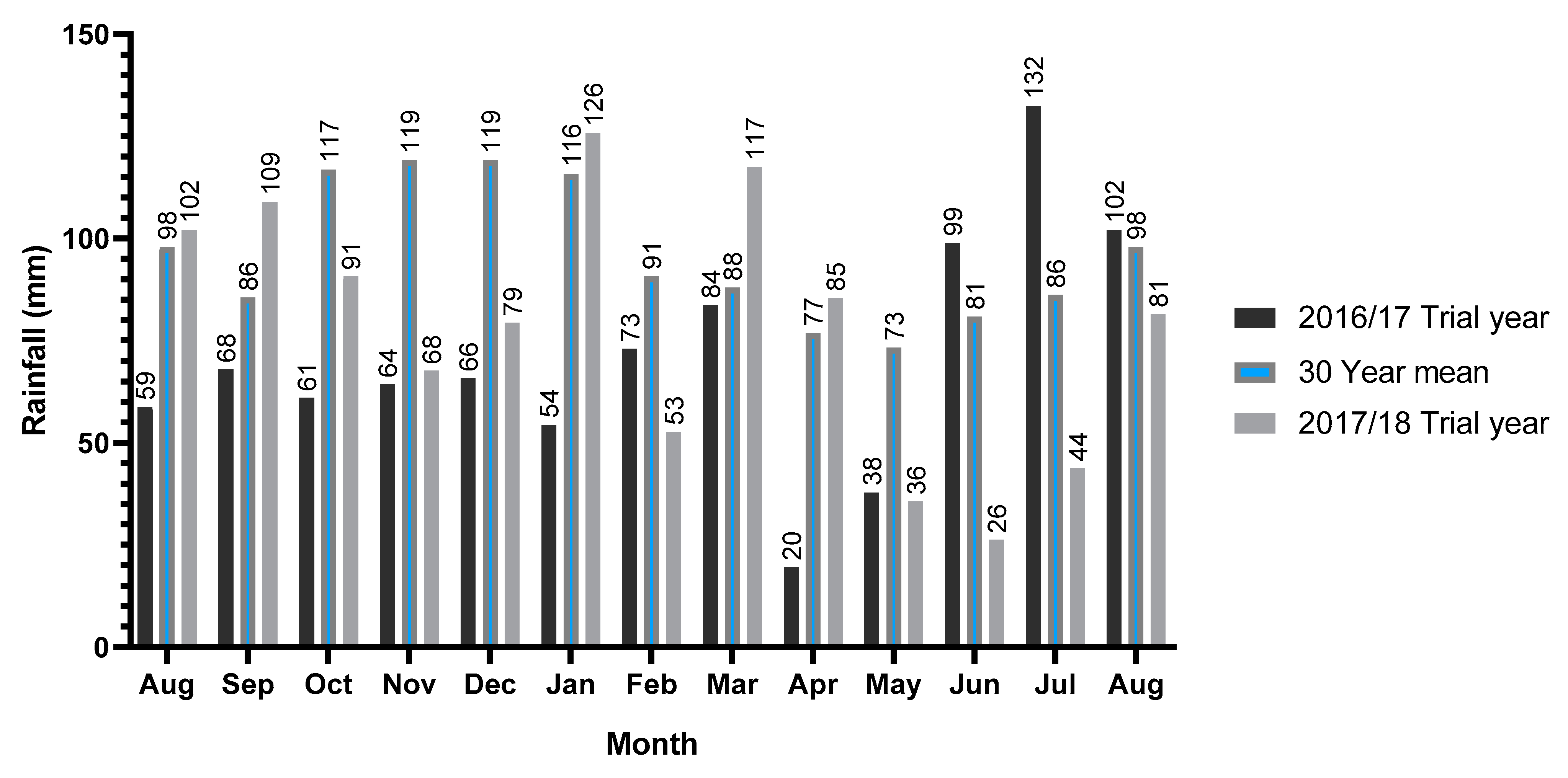
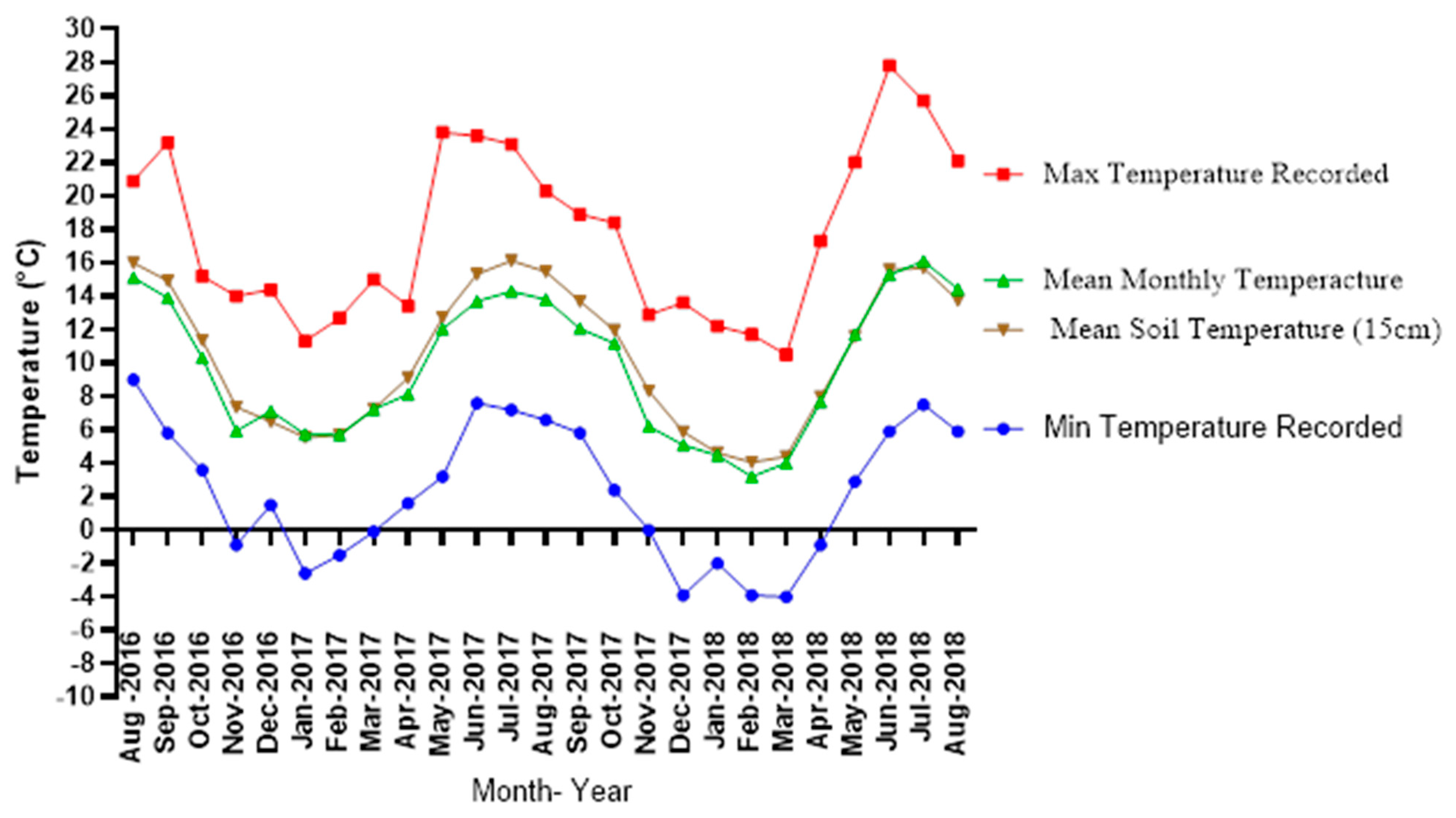
References
- Brust, J.; Weber, J.; Gerhards, R. Do cover crop mixtures have the same ability to suppress weeds as competitive monoculture cover crops? Julius-Kühn-Archiv 2014, 443, 422–430. [Google Scholar]
- Lord, J.S.; Lazzeri, L.; Atkinson, H.J.; Urwin, P.E. Biofumigation for Control of Pale Potato Cyst Nematodes: Activity of Brassica Leaf Extracts and Green Manures on Globodera pallida in Vitro and in Soil. J. Agric. Food Chem. 2011, 59, 7882–7890. [Google Scholar] [CrossRef] [PubMed]
- Aronsson, H.; Hansen, E.M.; Thomsen, I.K.; Liu, J.; Ogaard, A.F.; Känkänen, H.; Ulén, B. The ability of cover crops to reduce nitrogen and phosphorus losses from arable land in southern Scandinavia and Finland. J. Soil Water Conserv. 2016, 71, 41–55. [Google Scholar] [CrossRef]
- Couëdel, A.; Alletto, L.; Tribouillois, H.; Justes, É. Cover crop crucifer-legume mixtures provide effective nitrate catch crop and nitrogen green manure ecosystem services. Agric. Ecosyst. Environ. 2018, 254, 50–59. [Google Scholar] [CrossRef]
- Nivelle, E.; Verzeaux, J.; Habbib, H.; Kuzyakov, Y.; Decocq, G.; Roger, D.; Lacoux, J.; Duclercq, J.; Spicher, F.; Nava-Saucedo, J.-E.; et al. Functional response of soil microbial communities to tillage, cover crops and nitrogen fertilization. Appl. Soil Ecol. 2016, 108, 147–155. [Google Scholar] [CrossRef]
- Keogh, B.; McGrath, T.; Grant, J. The effect of sowing date and nitrogen on the dry-matter yield and nitrogen content of forage rape (Brassica napus L.) and stubble turnips (Brassica rapa L.) in Ireland. Grass Forage Sci. 2012, 67, 2–12. [Google Scholar] [CrossRef]
- Tribouillois, H.; Fort, F.; Cruz, P.; Charles, R.; Flores, O.; Garnier, E.; Justes, E. A Functional Characterisation of a Wide Range of Cover Crop Species: Growth and Nitrogen Acquisition Rates, Leaf Traits and Ecological Strategies. PLoS ONE 2015, 10, e0122156. [Google Scholar] [CrossRef]
- Teixeira, E.; Johnstone, P.; Chakwizira, E.; De Ruiter, J.; Malcolm, B.; Shaw, N.; Zyskowski, R.; Khaembah, E.; Sharp, J.; Meenken, E.; et al. Sources of variability in the effectiveness of winter cover crops for mitigating N leaching. Agric. Ecosyst. Environ. 2016, 220, 226–235. [Google Scholar] [CrossRef]
- Cottney, P.; Williams, P.N.; Black, L.E.; Cottney, P.; Williams, P.N.; Black, L.; White, E. The Perception and Use of Cover Crops within the Island of Ireland. Ann. Appl. Biol. 2021. [Google Scholar] [CrossRef]
- AHDB. Nutrient Management Guide (RB209). In Agriculture & Horticulture Development Board; AHDB: Warwickshire, UK, 2017. [Google Scholar]
- Frost, J.P.; Bailey, J.S.; Stevens, R.J. Making Best on-Farm Use of Plant Nutrients in Livestock Manures. In 78th Annual Report; Agricultural Research Insititute Northern Ireland (ARINI): Hillsborough, Northern Ireland, UK, 2004. [Google Scholar]
- Cottney, P.; Black, L.; White, E.; Williams, P.N. The Correct Cover Crop Species Integrated with Slurry Can Increase Biomass, Quality and Nitrogen Cycling to Positively Affect Yields in a Subsequent Spring Barley Rotation. Agronomy 2020, 10, 1760. [Google Scholar] [CrossRef]
- Parkin, T.B.; Kaspar, T.C.; Singer, J.W. Cover crop effects on the fate of N following soil application of swine manure. Plant Soil 2006, 289, 141–152. [Google Scholar] [CrossRef]
- Thilakarathna, M.S.; Serran, S.; Lauzon, J.; Janovicek, K.; Deen, B. Management of Manure Nitrogen Using Cover Crops. Agron. J. 2015, 107, 1595–1607. [Google Scholar] [CrossRef]
- Everett, L.A.; Wilson, M.L.; Pepin, R.J.; A Coulter, J. Winter Rye Cover Crop with Liquid Manure Injection Reduces Spring Soil Nitrate but Not Maize Yield. Agron. 2019, 9, 852. [Google Scholar] [CrossRef]
- Miguez, F.E.; Bollero, G.A. Review of Corn Yield Response under Winter Cover Cropping Systems Using Meta-Analytic Methods. Crop Sci. 2005, 45, 2318–2329. [Google Scholar] [CrossRef]
- Abdalla, M.; Hastings, A.; Cheng, K.; Yue, Q.; Chadwick, D.; Espenberg, M.; Truu, J.; Rees, R.M.; Smith, P. A critical review of the impacts of cover crops on nitrogen leaching, net greenhouse gas balance and crop productivity. Glob. Chang. Biol. 2019, 25, 2530–2543. [Google Scholar] [CrossRef]
- Giacomini, S.J.; Recous, S.; Mary, B.; Aita, C. Simulating the effects of N availability, straw particle size and location in soil on C and N mineralization. Plant Soil 2007, 301, 289–301. [Google Scholar] [CrossRef]
- Tripolskaja, L.; Šidlauskas, G. The influence of catch crops for green manure and straw on the infiltration of atmospheric precipitation and nitrogen leaching. Zemdirb. Agric. 2010, 97, 83–92. [Google Scholar]
- Janušauskaitė, D.; Arlauskienė, A.; Maikštėnienė, S. Soil mineral nitrogen and microbial parameters as influenced by catch crops and straw management. Zemdirb. Agric. 2013, 100, 9–18. [Google Scholar] [CrossRef]
- Zandt, D.I.T.; Fritz, C.; Wichern, F. In the land of plenty: Catch crops trigger nitrogen uptake by soil microorganisms. Plant Soil 2017, 423, 1–14. [Google Scholar]
- Kuzyakov, Y.; Xu, X. Competition between roots and microorganisms for nitrogen: Mechanisms and ecological relevance. New Phytol. 2013, 198, 656–669. [Google Scholar] [CrossRef]
- Nevins, C.J.; Nakatsu, C.; Armstrong, S. Characterization of microbial community response to cover crop residue decomposition. Soil Biol. Biochem. 2018, 127, 39–49. [Google Scholar] [CrossRef]
- Kramberger, B.; Gselman, A.; Janzekovic, M.; Kaligarič, M.; Bracko, B. Effects of cover crops on soil mineral nitrogen and on the yield and nitrogen content of maize. Eur. J. Agron. 2009, 31, 103–109. [Google Scholar] [CrossRef]
- Kaye, J.P.; Finney, D.; White, C.; Bradley, B.; Schipanski, M.; Alonso-Ayuso, M.; Hunter, M.; Burgess, M.; Mejia, C. Managing nitrogen through cover crop species selection in the U.S. mid-Atlantic. PLoS ONE 2019, 14, e0215448. [Google Scholar] [CrossRef]
- Tonitto, C.; David, M.; Drinkwater, L.E. Replacing bare fallows with cover crops in fertilizer-intensive cropping systems: A meta-analysis of crop yield and N dynamics. Agric. Ecosyst. Environ. 2006, 112, 58–72. [Google Scholar] [CrossRef]
- Samarappuli, D.; Johnson, B.L.; Kandel, H.; Berti, M.T. Biomass yield and nitrogen content of annual energy/forage crops preceded by cover crops. Field Crop. Res. 2014, 167, 31–39. [Google Scholar] [CrossRef]
- White, C.M.; Dupont, S.T.; Hautau, M.; Hartman, D.; Finney, D.M.; Bradley, B.; Lachance, J.C.; Kaye, J.P. Managing the trade off between nitrogen supply and retention with cover crop mixtures. Agric. Ecosyst. Environ. 2017, 237, 121–133. [Google Scholar] [CrossRef]
- Kremen, A.; Weil, R. Nitrogen mineralization from brassica cover crops. In Cover Crops for Soil Health and Sustainable Farming; University of Maryland: College Park, MD, USA, 2006; p. 115. [Google Scholar]
- Justes, E.; Mary, B.; Nicolardot, B. Quantifying and modelling C and N mineralization kinetics of catch crop residues in soil: Parameterization of the residue decomposition module of STICS model for mature and non mature residues. Plant Soil 2009, 325, 171–185. [Google Scholar] [CrossRef]
- Silgram, M.; Harrison, R. The Mineralisation of Nitrogen in Cover Crops: A Review; Department of Environment and Rural Affairs: London, UK, 1998.
- Melkonian, J.; Poffenbarger, H.J.; Mirsky, S.B.; Ryan, M.R.; Moebius-Clune, B.N. Estimating Nitrogen Mineralization from Cover Crop Mixtures Using the Precision Nitrogen Management Model. Agron. J. 2017, 109, 1944–1959. [Google Scholar] [CrossRef]
- Mead, R.; Curnow, R.N.; Hasted, A. (Eds.) Statistical Methods. In Agriculture and Experimental Biology, 3rd ed.; Texts in Statistical Science 2003; Chapman & Hall/CRC: Boca Raton, FL, USA, 2003. [Google Scholar]
- VSN International. Genstat for Windows, 18th ed.; VSN International: Hemel Hempstead, UK, 2017. [Google Scholar]
- White, E.M.; Wilson, F.E.A.; Kettlewell, P.S.; Sklyvester-Bradley, R.; Watson, C. Nitrogen nutrition of wheat at three contrasting sites in the UK. Asp. Appl. Biol. 1997, 50, 241–247. [Google Scholar]
- Li, C.-X.; Ma, S.-C.; Shao, Y.; Ma, S.-T.; Zhang, L.-L. Effects of long-term organic fertilization on soil microbiologic characteristics, yield and sustainable production of winter wheat. J. Integr. Agric. 2018, 17, 210–219. [Google Scholar] [CrossRef]
- Glendining, M.; Powlson, D. The Effect of Long-term Applications of Inorganic Nitrogen Fertilizer on Soil Organic Nitrogen. Adv. Soil Org. Matter Res. 2003, 127, 329–338. [Google Scholar]
- Guntiñas, M.E.; Leirós, M.C.; Trasarcepeda, C.; Gil-Sotres, F. Effects of moisture and temperature on net soil nitrogen mineralization: A laboratory study. Eur. J. Soil Biol. 2012, 48, 73–80. [Google Scholar] [CrossRef]
- De Neve, S.; Hofman, G. Quantifying soil water effects on nitrogen mineralization from soil organic matter and from fresh crop residues. Biol. Fertil. Soils 2002, 35, 379–386. [Google Scholar] [CrossRef]
- DAERA. EU Farm Structure Survey 2016 Northern Ireland. In CAP Policy, Economics and Statistics Division; Department of Agriculture, Environment and Rural Affairs Belfast: Belfast, Northern Ireland, UK, 2016. [Google Scholar]
- White, C.M.; Finney, D.M.; Kemanian, A.R.; Kaye, J.P. A Model-Data Fusion Approach for Predicting Cover Crop Nitrogen Supply to Corn. Agron. J. 2016, 108, 2527–2540. [Google Scholar] [CrossRef]
- Seman-Varner, R.; Varco, J.; O’Rourke, M. Nitrogen Benefits of Winter Cover Crop and Fall-Applied Poultry Litter to Corn. Agron. J. 2017, 109, 2881–2888. [Google Scholar] [CrossRef]
- Salmerón, M.; Isla, R.; Cavero, J. Effect of winter cover crop species and planting methods on maize yield and N availability under irrigated Mediterranean conditions. Field Crop. Res. 2011, 123, 89–99. [Google Scholar] [CrossRef]
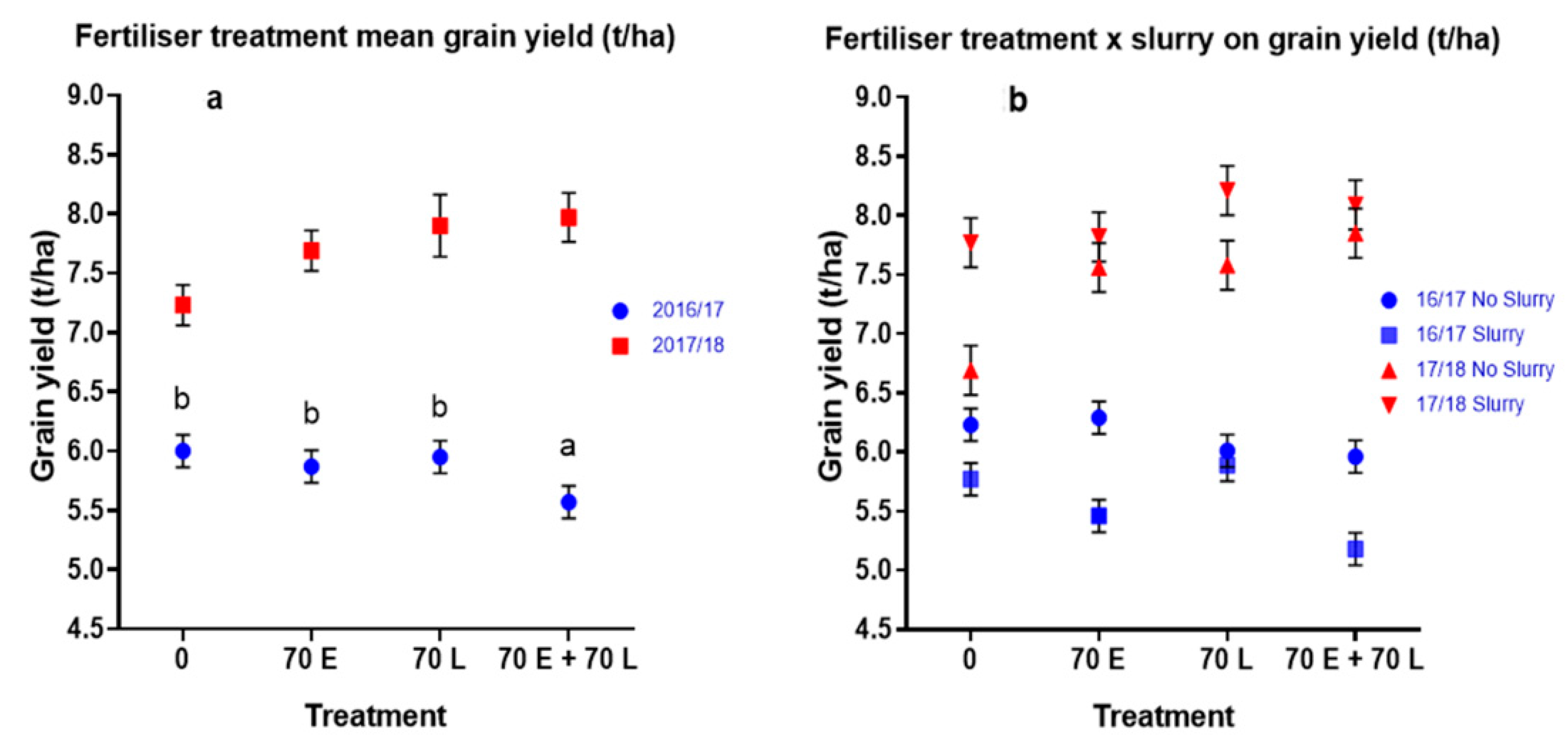
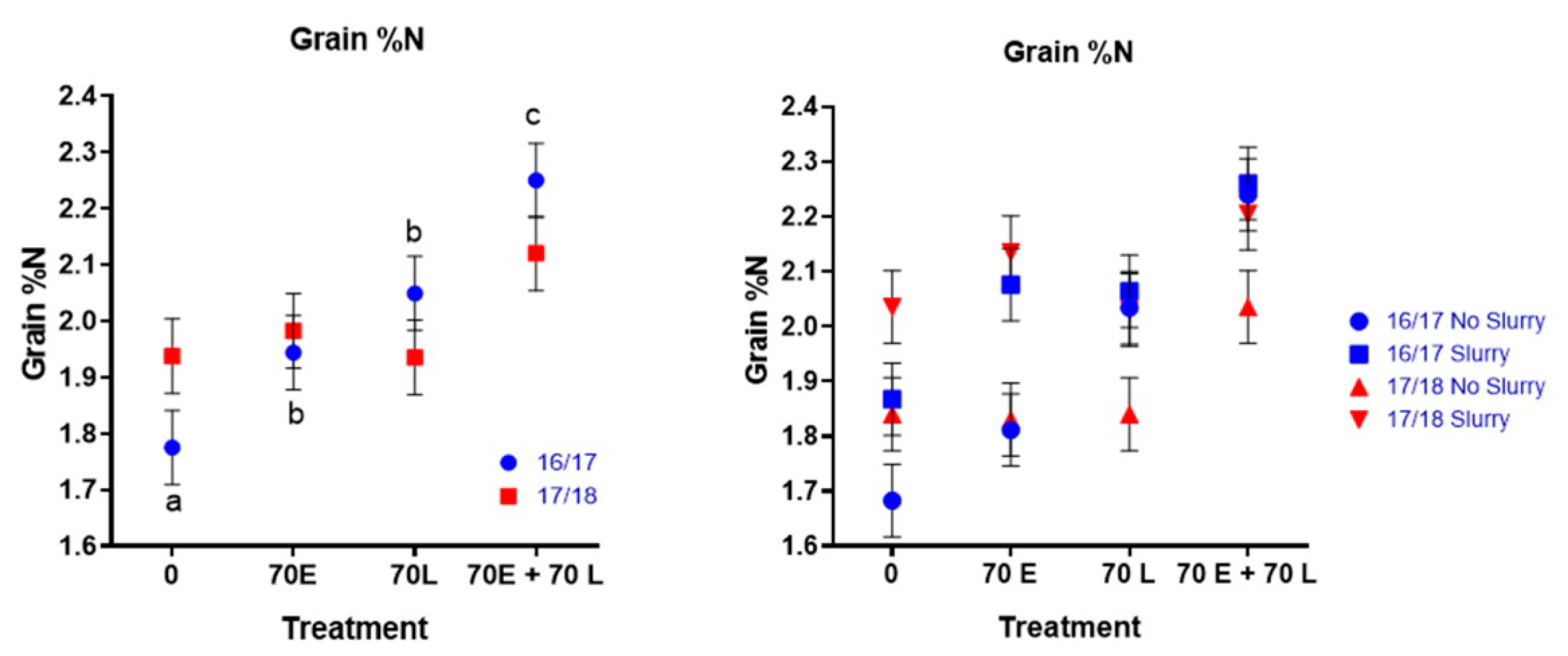

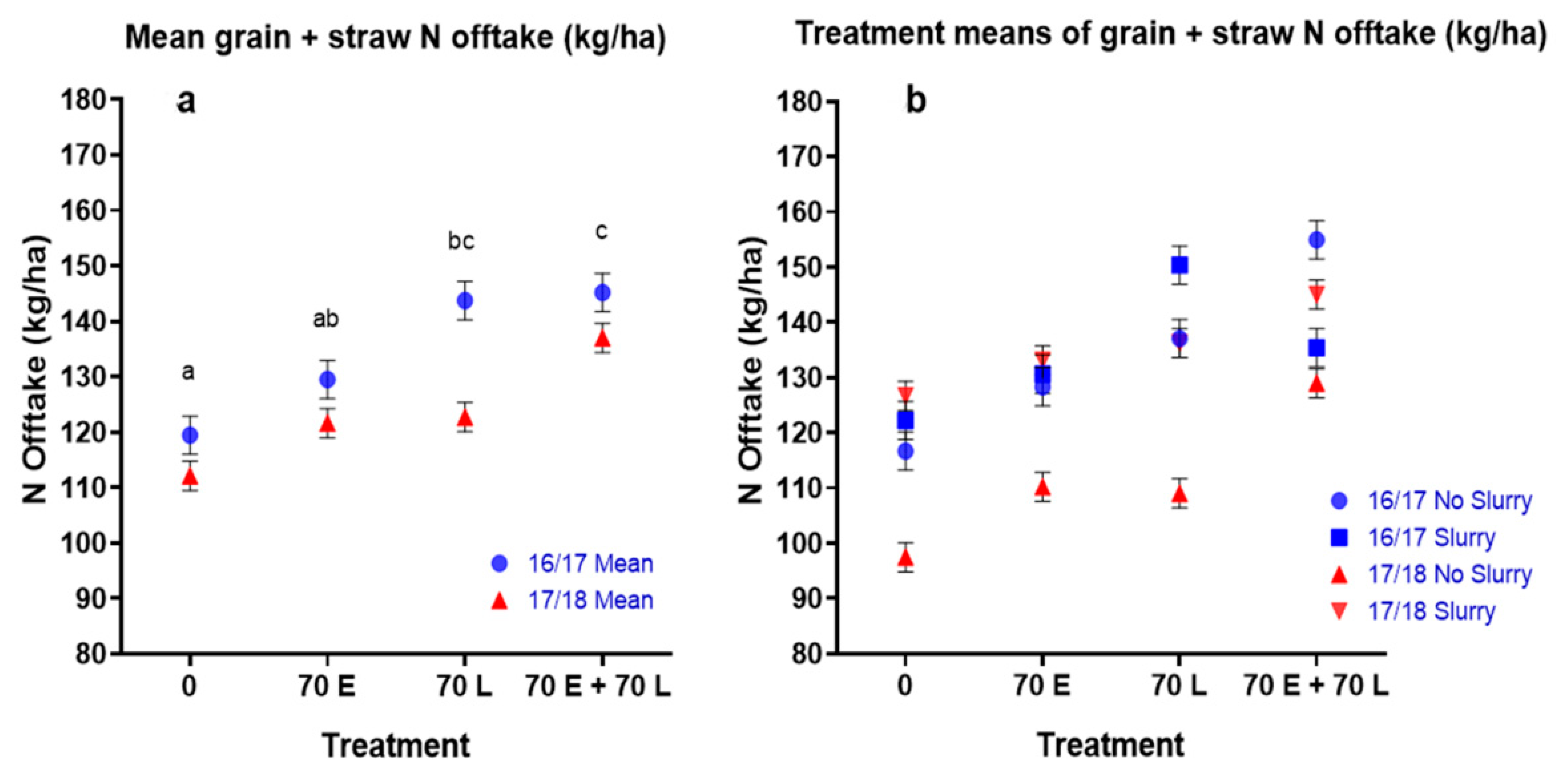
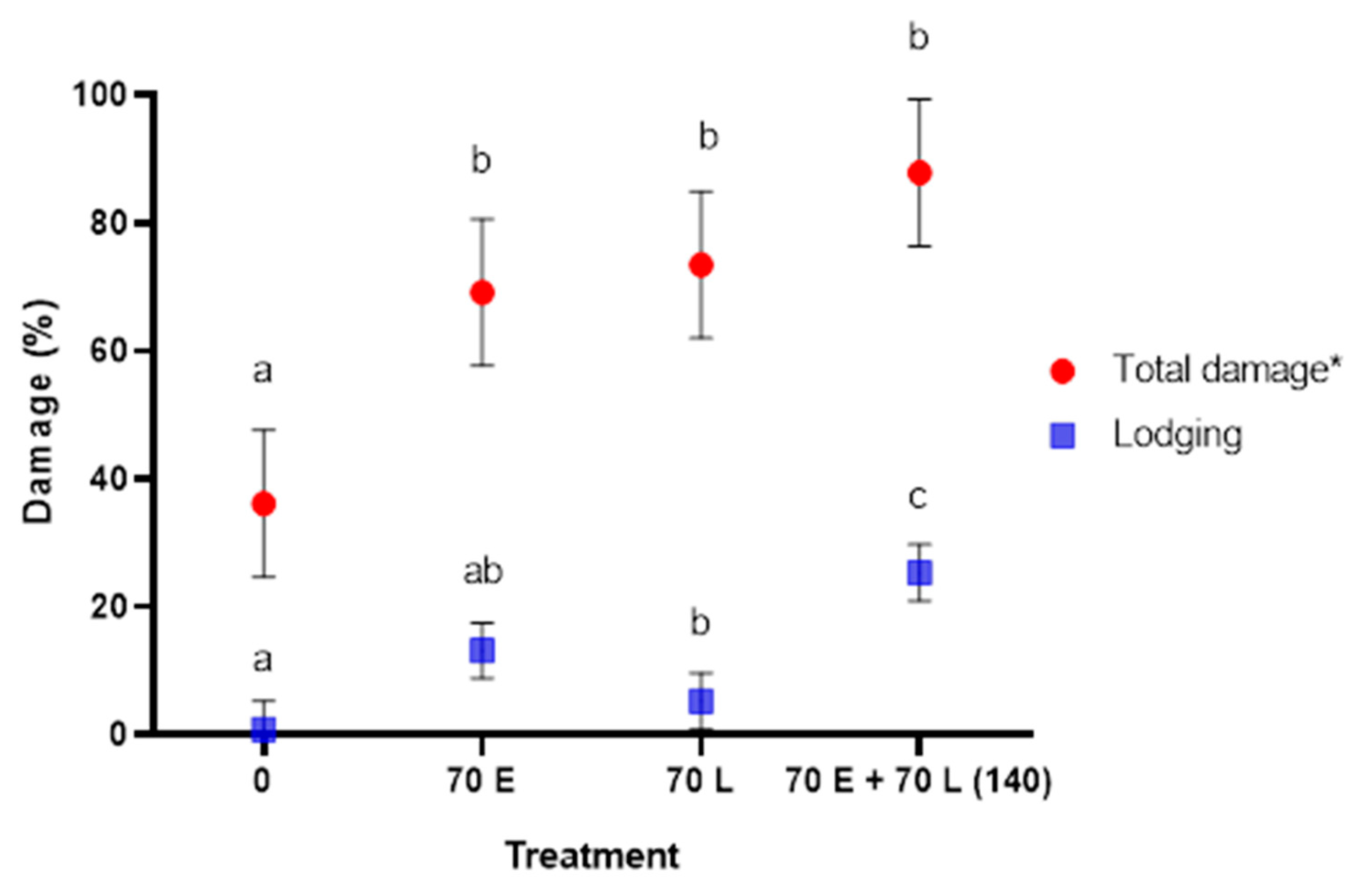
| Year | Site | pH | Phosphorus (P) | Potassium (K) | Magnesium (Mg) | Sulphur (S) | TN # | TC + | Sand | Silt | Clay |
|---|---|---|---|---|---|---|---|---|---|---|---|
| mg/L Soil * | mg/L Soil | mg/L Soil | mg/L Soil | % | % | % | % | % | |||
| 2016/17 | Site 1 | 5.93 | 95.0 | 205 | 214 | 9.3 | 0.491 | 4.0 | 42.8 | 36.7 | 20.5 |
| 2017/18 | Site 2 | 6.72 | 30.5 | 205 | 93 | 41.9 | 0.355 | 3.6 | 49.4 | 32.7 | 17.9 |
| Year | Plant Fraction | Mean Yield | Phosphorus (P) | Potassium (K) | Calcium (Ca) | Magnesium (N) | Sulphur (S) | N | C:N Ratio |
|---|---|---|---|---|---|---|---|---|---|
| t/ha | % | % | % | % | % | % | |||
| 2016/17 | Stem | 2.12 | 0.6 | 4.1 | 1.9 | 0.3 | 0.6 | 3.5 | - |
| Root | 1.94 | 0.5 | 4.8 | 0.7 | 0.2 | 0.3 | 1.9 | - | |
| 2017/18 | Stem | 3.43 | 0.5 | 4.8 | 1.3 | 0.1 | 0.6 | 3.4 | 12.2 |
| Root | 1.07 | 0.5 | 4.3 | 0.9 | 0.3 | 0.6 | 2.9 | 16.4 | |
| Nutrient uptake (kg/ha) | |||||||||
| Total 2017 | Stem | 11.8 | 86.2 | 40.8 | 6.5 | 11.7 | 73.9 | ||
| Root | 8.9 | 92.9 | 13.8 | 3.2 | 6.1 | 37.3 | |||
| Sum | 20.8 | 179.1 | 54.5 | 9.7 | 17.8 | 111.2 | |||
| Total 2018 | Stem | 18.7 | 165.4 | 43.8 | 5.1 | 22.1 | 118.0 | ||
| Root | 5.5 | 46.3 | 10.0 | 2.7 | 6.7 | 31.5 | |||
| Sum | 24.2 | 211.7 | 53.8 | 7.8 | 28.8 | 149.5 | |||
| Block 1 | Block 2 | ||||||
|---|---|---|---|---|---|---|---|
| B | A | C | D | B | D | A | C |
| D | A | C | B | A | D | B | C |
| D | A | B | C | C | B | A | D |
| D | B | A | C | A | B | C | D |
| Slurry was randomised in columns, whilst fertiliser treatment was randomised across rows | |||||||
| A = 0 kg N/ha (0) | B = 70 kg N/ha Early (70 E) | C = 70 kg N/ha Late (70 L) | D = 70 E + 70 L kg N/ha (70 E + 70 L) | ||||
| Red font | Slurry | ||||||
| Normal font | Nil slurry | ||||||
| Treatment | Block 1 | Block 2 | ||||||
|---|---|---|---|---|---|---|---|---|
| Sub plot | 70 E + | 70 E + | 70 E + | 70 E + | 70 E + | 70 E + | 0 + | 0 + |
| Sub-sub plot | 70 L | 0 | 0 | 70 L | 70 L | 0 | 0 | 70 L |
| 0 + | 0 + | 0 + | 0 + | 0 + | 0 + | 70 E + | 70 E + | |
| 70 L | 0 | 70 L | 0 | 0 | 70 L | 0 | 70 L | |
| Whole plot = Slurry, Sub plot = 70 kg N/ha applied early (70 E) or 0 kg N/ha (0), Sub-sub plots = 70 kg N/ha applied late (70 L) or 0 kg N/ha (0) | ||||||||
| Red font | Slurry | |||||||
| Normal font | Nil slurry | |||||||
| Grain Yield (t/ha) | Straw Yield (t/ha) | |||||
|---|---|---|---|---|---|---|
| Parameter | F-Value | SEM * | LSD # | F-Value | SEM | LSD |
| Slurry | 0.04 | 0.158 | 0.456 | 0.67 | 0.053 | 0.152 |
| Nitrogen | 0.03 | 0.138 | 0.258 | 0.46 | 0.054 | 0.199 |
| Slurry × Nitrogen | 0.17 | 0.138 | 0.583 | <0.01 | 0.052 | 0.291 |
| Grain Yield t/ha—15% MC | Straw Yield t/ha—15% MC | |||||
|---|---|---|---|---|---|---|
| Treatment | F-Value | SEM * | LSD # | F-Value | SEM | LSD |
| Slurry | 0.29 | 0.193 | 3.465 | 0.18 | 0.113 | 2.031 |
| Early N (70 E) | 0.39 | 0.17 | 1.070 | <0.01 | 0.02 | 0.12 |
| Slurry × Early N (70E) | 0.34 | 0.109 | 0.427 | <0.05 | 0.039 | 0.153 |
| Late N (70 L) | <0.05 | 0.261 | 1.322 | <0.05 | 0.115 | 1.793 |
| Slurry × Late N (70 L) | 0.49 | 0.221 | 1.61 | 0.12 | 0.12 | 1.361 |
| 140 | 0.28 | 0.207 | 0.853 | 0.31 | 0.044 | 0.155 |
| Slurry × 140 (70 E + 70 L) | 0.53 | 0.303 | 1.166 | 0.23 | 0.127 | 1.002 |
| 2016/17 | 2017/18 | |||||||||
|---|---|---|---|---|---|---|---|---|---|---|
| Treatment | 0 | 70 E | 70 L | 70 E + 70 L | Average | 0 | 70 E | 70 L | 70 E + 70 L | Average |
| No Slurry | 2.4 | 2.4 | 2.4 | 2.6 | 2.5 | 2.20 | 2.30 | 2.51 | 2.64 | 2.41 |
| Slurry | 2.6 | 2.3 | 2.6 | 2.2 | 2.4 | 1.56 | 2.09 | 1.80 | 2.05 | 1.88 |
| Average | 2.5 | 2.4 | 2.5 | 2.4 | 2.45 | 1.88 | 2.19 | 2.16 | 2.35 | 2.14 |
| Treatment | Grain N% | Specific Weight (kg/hl) | TGW (g) | ||||||
|---|---|---|---|---|---|---|---|---|---|
| F-Value | SEM * | LSD # | F-Value | SEM | LSD | F-Value | SEM | LSD | |
| Slurry | <0.01 | 0.065 | 0.087 | 0.03 | 0.670 | 0.886 | 0.11 | 0.780 | 2.934 |
| Nitrogen | <0.001 | 0.065 | 0.123 | <0.001 | 0.676 | 1.253 | <0.01 | 0.782 | 2.516 |
| Slurry × Nitrogen | 0.26 | 0.066 | 0.189 | 0.96 | 0.670 | 1.965 | 0.50 | 0.761 | 5.201 |
| Grain N% | Specific Weight (kg/hl) | TGW (g) | |||||||
|---|---|---|---|---|---|---|---|---|---|
| Treatment | F-Value | SEM * | LSD # | F-value | SEM | LSD | F-Value | SEM | LSD |
| Slurry | 0.23 | 0.058 | 1.048 | 0.19 | 0.03 | 0.48 | 0.78 | 0.89 | 15.92 |
| Early N (70 E) | <0.001 | 0.003 | 0.017 | 0.10 | 0.13 | 0.80 | 0.16 | 0.43 | 2.64 |
| Slurry × Early N (70 E) | 0.03 | 0.022 | 0.087 | 0.61 | 0.35 | 1.37 | 0.46 | 0.32 | 1.27 |
| Late N (70 L) | 0.10 | 0.058 | 1.038 | 0.40 | 0.13 | 0.76 | 0.93 | 0.99 | 8.44 |
| Slurry × Late N (70 L) | 0.33 | 0.062 | 0.661 | 0.88 | 0.35 | 1.37 | 0.53 | 0.94 | 10.28 |
| 140 (70 E + 70 L) | 0.09 | 0.022 | 0.087 | 0.74 | 0.37 | 1.36 | 0.90 | 0.54 | 2.09 |
| Slurry × 140 (70 E + 70 L) | 0.36 | 0.066 | 0.505 | 0.98 | 0.51 | 1.92 | 0.09 | 1.09 | 6.14 |
| Parameter | F-Value | SEM * | LSD # |
|---|---|---|---|
| Slurry | 0.94 | 3.67 | 10.82 |
| Nitrogen | <0.001 | 3.65 | 14.92 |
| Slurry × Nitrogen | 0.16 | 3.46 | 21.59 |
| Treatment | F-Value | SEM * | LSD # |
|---|---|---|---|
| Slurry | <0.05 | 0.65 | 11.68 |
| Early N (70 E) | 0.08 | 2.57 | 15.65 |
| Slurry × Early N (70 E) | 0.35 | 2.38 | 9.36 |
| Late N (70 L) | <0.05 | 2.65 | 14.56 |
| Slurry × Late N (70 L) | 0.55 | 2.47 | 9.28 |
| 140 (70 E + 70 L) | 0.51 | 3.51 | 12.71 |
| Slurry × 140 (70E + 70 L) | 0.73 | 4.29 | 14.71 |
| Treatment | Leaning | Lodging | Brackling | Necking | Total Damage |
|---|---|---|---|---|---|
| Slurry | 0.67 | <0.05 | 0.82 | 0.47 | 0.09 |
| Nitrogen | 0.40 | <0.001 | 0.15 | 0.50 | <0.001 |
| Slurry × Nitrogen | 0.34 | 0.31 | 0.60 | 0.85 | 0.55 |
| Stubble Turnips | ||
|---|---|---|
| N (kg/ha) | 2016–17 | 2017–18 |
| Total N applied as slurry to the cover crop | 106 | 261 |
| Total N recovered by the cover crop | 111 | 149 |
| Apparent efficiency of recovery of N by the cover crop (%) | 105 | 57 |
| Spring barley | ||
| Total N applied as slurry prior to spring barley | 137 | 147 |
| Total N recovered by spring barley with 0 inorganic N | ||
| Without slurry | 117 | 98 |
| With slurry | 122 | 127 |
| Total N applied from slurry | 243 | 408 |
| Apparent efficiency of recovery of N by the 0 N barley crop (%) | ||
| Without slurry | 110 | 38 |
| With slurry (pre-spring barley) | 50 | 31 |
Publisher’s Note: MDPI stays neutral with regard to jurisdictional claims in published maps and institutional affiliations. |
© 2021 by the authors. Licensee MDPI, Basel, Switzerland. This article is an open access article distributed under the terms and conditions of the Creative Commons Attribution (CC BY) license (http://creativecommons.org/licenses/by/4.0/).
Share and Cite
Cottney, P.; Williams, P.N.; White, E.; Black, L. Investigation of the Effect of Slurry, Combined with Inorganic N Rate and Timing, on the Yield of Spring Barley Post Cover Crop of Stubble Turnips. Agronomy 2021, 11, 232. https://doi.org/10.3390/agronomy11020232
Cottney P, Williams PN, White E, Black L. Investigation of the Effect of Slurry, Combined with Inorganic N Rate and Timing, on the Yield of Spring Barley Post Cover Crop of Stubble Turnips. Agronomy. 2021; 11(2):232. https://doi.org/10.3390/agronomy11020232
Chicago/Turabian StyleCottney, Paul, Paul N. Williams, Ethel White, and Lisa Black. 2021. "Investigation of the Effect of Slurry, Combined with Inorganic N Rate and Timing, on the Yield of Spring Barley Post Cover Crop of Stubble Turnips" Agronomy 11, no. 2: 232. https://doi.org/10.3390/agronomy11020232
APA StyleCottney, P., Williams, P. N., White, E., & Black, L. (2021). Investigation of the Effect of Slurry, Combined with Inorganic N Rate and Timing, on the Yield of Spring Barley Post Cover Crop of Stubble Turnips. Agronomy, 11(2), 232. https://doi.org/10.3390/agronomy11020232






